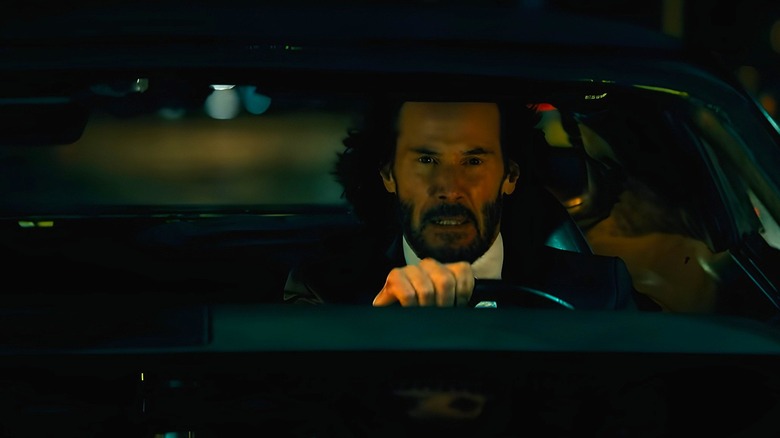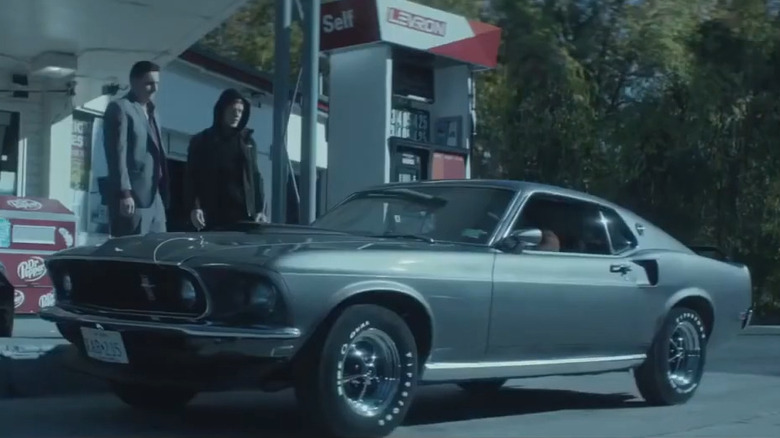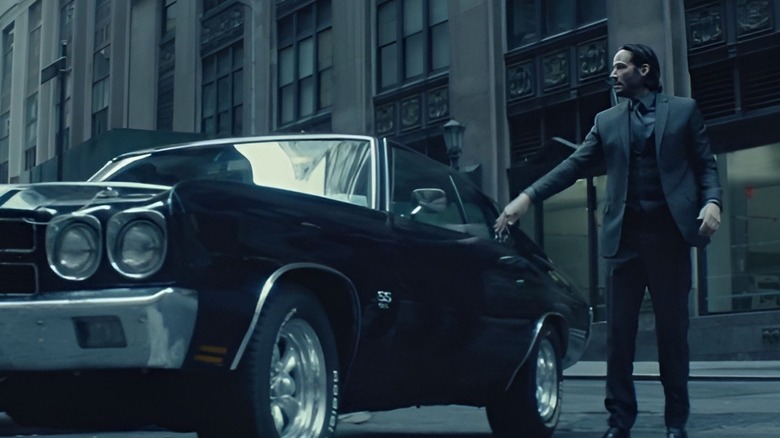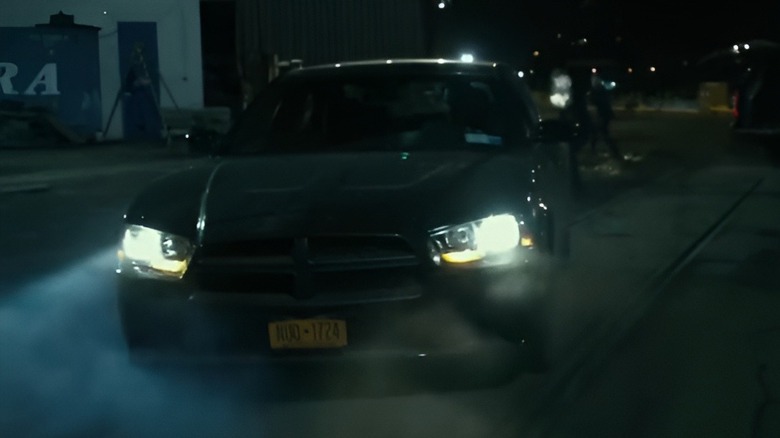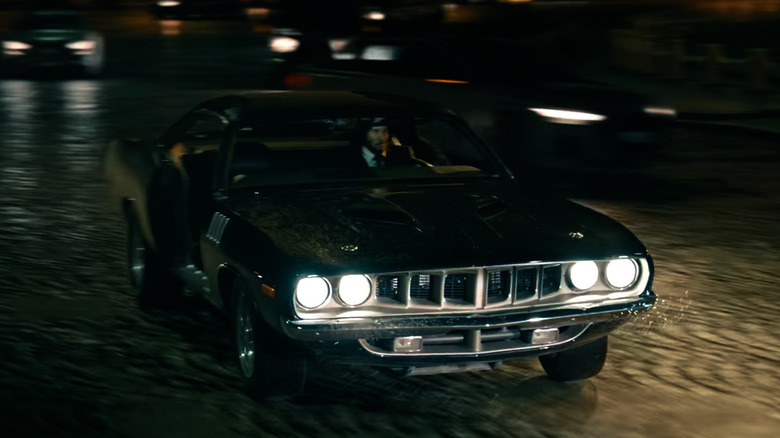Every Muscle Car Keanu Reeves Drives In John Wick
Over a decade ago, the face of action movies was changed forever with the release of "John Wick." The film follows the exploits of the esteemed titular hitman, portrayed by Keanu Reeves, who comes out of retirement to enact vengeance on a band of gangsters who do him wrong. Released in October 2014, "John Wick" became a surprise critical and financial hit, going on to launch a newfound interest in Reeves as an actor and a fan-favorite franchise that currently sports three similarly successful sequels that have collectively grossed over $1 billion worldwide.
The film series may be well-renowned for its hard-hitting hand-to-hand fight sequences and intense shoot outs, but equally worthy of mention are the franchise's many impressive car chases and stunts. Along with being fun to witness for their immense spectacle, car aficionados always get a kick from spotting their favorite rides show up — even if they know that they likely won't make it to the end credits in one piece. Nevertheless, the various muscle vehicles that show up in the "John Wick" series are integral to imbuing the franchise with both its unforgettable action and stylish flair. It's time we take our own drive down memory lane as we take a look at every muscle car driven by Keanu Reeves across the "John Wick" movies.
Ford Mustang Boss 429
It may be easy to forget that a muscle car is partially responsible for the conflict that arises in the original "John Wick." Early on in the film, Wick's simple stop at a gas station to fill up his 1969 Ford Mustang is interrupted by a group of gangsters who try to push him into selling them the car but to no avail. This leads to the murder of his innocent beagle puppy at the hands of the dangerous strangers, who take things a step further by stealing the car, unaware of the fury that's been unleashed.
As despicable as the evil-doers truly are, it's hard to not be similarly impressed by Wick's ride. The specific Mustang seen here is the high-performing Boss 429, a specialized variant made by Ford as a legitimate NASCAR competitor. In particular, Ford had eyes on topping the powerful Chrysler 426 Hemi engine which had seen great success on the race track throughout the decade. Ford found the success it was looking for, becoming a big winner throughout the 1969 NASCAR season with 26 victories. Only 1,358 Boss 429s were produced over the course of 1969 and 1970, with 859 being produced during the former year.
Given the extreme rarity of the 1969 Boss 429 in particular, it's easy to see why Wick would be so reluctant to give it away, let alone to some bums at a gas station. However, a sharp eye will be able to spot certain details that clue in that this particular Boss 429 has had some modifications, such as its automatic transmission, no badging, and Shelby logo steering wheel.
1970 Chevelle SS 396
Even if John Wick's Mustang is given most of the noteworthy focus in the first film, it's not the only muscle car that plays a role in the film. While his Mustang is gone, Wick is given another famous muscle car from that era to ride around in, a 1970 Chevrolet Chevelle SS 396. It plays an even bigger role at the start of 2017's "John Wick: Chapter 2", where the skilled assassin seeks the brother of Iosef Tarasov in an effort to reclaim his Mustang and races a motorcycle throughout the city with his Chevelle.
While not equalling the Mustang in its overall screen time or importance to the overall narrative, the Chevelle still deserves plenty of love. Initially designed as a competitor to the Ford Fairlane, the car seen in "John Wick: Chapter 2" is part of the second generation Chevelle produced between 1969 and 1972. The 1970 model came with a wider range of engine packages, with the ability to upgrade the SS 396's standard V8 engine to 375 horsepower. It also had its fair share of unique aesthetic features such its a distinct square shape and specially designed grille.
2011 Dodge Charger SXT
While his Chevelle SS 396 made for an impressive car to open "John Wick: Chapter 2," the vehicle that Wick would be behind for the finale of the first film would end up being a 2011 Dodge Charger SXT. At first glance, this may seem a bit out of character for the franchise given its aptitude for the more classic rides. But given what Wick's car would have to endure, it's easy to imagine the filmmakers' hesitation at throwing an older set of wheels at the mercy of the movie's chaotic climax.
The reasoning behind this change of aesthetic, while never officially explained, has been attributed to a number of factors. The most likely were budgetary and resource constraints. Getting a classic Mustang or Chevy for a few scenes of Keanu Reeves driving around may come with a few challenges, but for a finale that required multiple cars to get decimated, getting a bunch of rare, expensive cars to get wrecked would have simply been a producer's nightmare to decipher. As the first film had a relatively modest budget of $20 million (compared to the $100 million spent on "John Wick: Chapter 4"), this was more than likely a corner that the production had to cut corners on. Additionally, its four door design made it easier to mount cameras and other equipment to the vehicle.
Make no mistake, this isn't to discount the Charger SXT's effectiveness as a whole. While not the most aggressive form of the Charger you'll find, acting only as a base trim model, the SXT, which stands for Standard Extra, remains a stylish and powerful enough to prove an entertaining car to see rip roaring through bad guys.
1971 Plymouth Barracuda
For the latest installment of the "John Wick" franchise, it's safe to say that Keanu Reeves and company weren't afraid to go all out for the film's defying car stunts. But this time, Wick was able to get his hands around the steering wheel of another classic muscle car with a 1971 Plymouth Barracuda. Even though the Mustang is well-known for cementing the sport car trend of the mid 1960s and 1970s, it was Chrysler that beat Ford to the punch, releasing their pony car on April 1, 1964, only a few weeks prior to the Mustang's debut. The 1971 Barracuda would be part of the last generation of this iconic lineup that released between 1970 and 1974.
Even in its final phase, this ride kept the features that saw it garner widespread appeal among car enthusiasts and families alike. With the previous year's Barracuda pushing for a heavier emphasis on its style, the following would add on its own minor variances in the taillights, grille, trim, and a set of four headlights unique to this particular Barracuda year.
While Reeves had pulled off some impressive car stunts in prior entries, it's safe to say that "John Wick: Chapter 4" was the most daunting effort behind the wheel yet for both Reeves and the stunt team. He described some of these challenges in an interview with People magazine, sharing, "We took the car-driving to the next level, which I really enjoy. There's 180s, forward-into-reverse 180s, reverse-into-forward 270s, drifting.... So it was really fun to get a chance to learn those skills, and to play."
